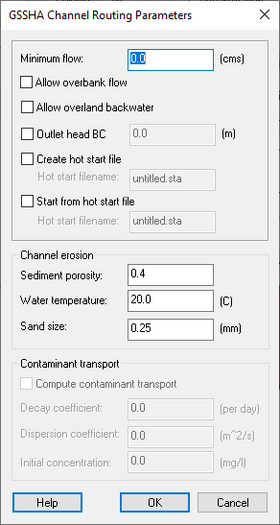WMS:GSSHA Channel Routing
Parameters for stream channels in GSSHA are defined using arcs and then mapped to the appropriate underlying grid cells. In order to define GSSHA channel parameters using arcs, the current coverage type must be set to "GSSHA". GSSHA is a two-dimensional finite difference rainfall/runoff model. A finite difference grid is used to establish the computational domain and parameters for surface runoff. The GSSHA model is fully coupled with hydraulic stream flow/routing models.
Smoothing Stream Cells
Because elevation data used to define the surface runoff component of GSSHA does not contain the detailed resolution required to capture the actual stream bed elevation of the channels, the bed elevation profile can be highly irregular. These abrupt changes in elevation can cause instabilities in the channel routing computations, and therefore must be smoothed out.
The Smooth Stream Arcs command is used to adjust the elevation of the stream bed for GSSHA:
- Select a continuous set of arcs which represent the stream
- Select GSSHA | Smooth Stream Arcs
Initially, the bed elevation is assigned the same value as the grid. Whenever a profile is shown, the bed elevation profile is displayed in blue while the grid elevation of the cell is shown in red. Make sure that no bed elevation is higher than the grid cell elevation.
Renumber Links and Nodes
In order to properly execute the channel routing routines of GSSHA, the stream channel must have the proper order and connectivity. This ordering or numbering can be done automatically by selecting GSSHA | Renumber Links and Nodes.
Links define whole channel segments and must therefore be numbered in ascending order from upstream to downstream. In other words, all channel segments must flow into downstream segments with a higher link number.
GSSHA Channel Routing Parameters Dialog
The GSSHA Channel Routing Parameters dialog is accessed by selecting Diffusive wave in the Channel routing computation scheme section of the GSSHA Job Control Parameters dialog, then clicking Edit Parameters.... It has the following options:
- Top section
- Minimum flow – A decimal value in cms.
- Allow overbank flow – Allow water in channel to flow back onto overland flow plane when stream elevation is above top of bank and the adjacent overland cell elevation.
- Allow overland backwater – Include backwater effects on overland when stream water surface elevation or TOB is greater than overland flow surface elevation without allowing water in channel to flow back onto overland.
- Outlet head BC – A decimal value in meters.
- Create hot start file – Turn on to create a hot start file.
- Start from hot start file – Turn on to specify a hot start file.
- Channel erosion section
- Sediment porosity – Value of the porosity of the channel bed sediments (0.0–1.0).
- Water temperature – The water temperature in a decimal number (degrees Celsius).
- Sand size – The diameter of the sediment particle. A decimal value in millimeters.
- Contaminant transport section
- Compute contaminant transport – Activates inputs for contaminant transport in the model.
- Decay coefficient – A decimal value per day of the first order decay coefficient of constituents in the channel.
- Dispersion coefficient – A decimal value in m2 per second.
- Initial concentration – The beginning concentration of a contaminant. A decimal value in milligrams per liter.
At the bottom are three buttons:
- Help – Opens this section on this page in a web browser.
- OK – Saves all changes made and exits the GSSHA Channel Routing Parameters dialog.
- Cancel – Discards all changes made and exits the GSSHA Channel Routing Parameters dialog.
Related Topics
| [hide] GSSHA | |
|---|---|
| XMS Wiki Links | Calibration (Automated • Manual • Output) • Channel Routing • Contaminants • Digital Dams • Embankment Arcs • Feature Objects (Arcs • Nodes • Polygons) • File Types • Groundwater • Groups • Hydraulic Structures • Job Control • Join SSURGO Data • Mapping Tables • Maps • Menu • Model Linkage • Multiple Simulations • Nutrients • Observations • Output Control • Overland Soil Erosion • Pipe and Node Parameters • Precipitation • Radar Rainfall • Save GSSHA Project File • Smooth GSSHA Streams • Snowmelt • Solution (Analysis • Data) |
| Related Tools | MWBM Wizard • Using Soil Type Data with GSSHA |
| GSSHA Wiki External Links | GSSHA Wiki: Overview • Primer • User's Manual • Tutorials |
| [hide] WMS – Watershed Modeling System | ||
|---|---|---|
| Modules: | Terrain Data • Drainage • Map • Hydrologic Modeling • River • GIS • 2D Grid • 2D Scatter |  |
| Models: | CE-QUAL-W2 • GSSHA • HEC-1 • HEC-HMS • HEC-RAS • HSPF • MODRAT • NSS • OC Hydrograph • OC Rational • Rational • River Tools • Storm Drain • SMPDBK • SWMM • TR-20 • TR-55 | |
| Toolbars: | Modules • Macros • Units • Digitize • Static Tools • Dynamic Tools • Drawing • Get Data Tools | |
| Aquaveo | ||
